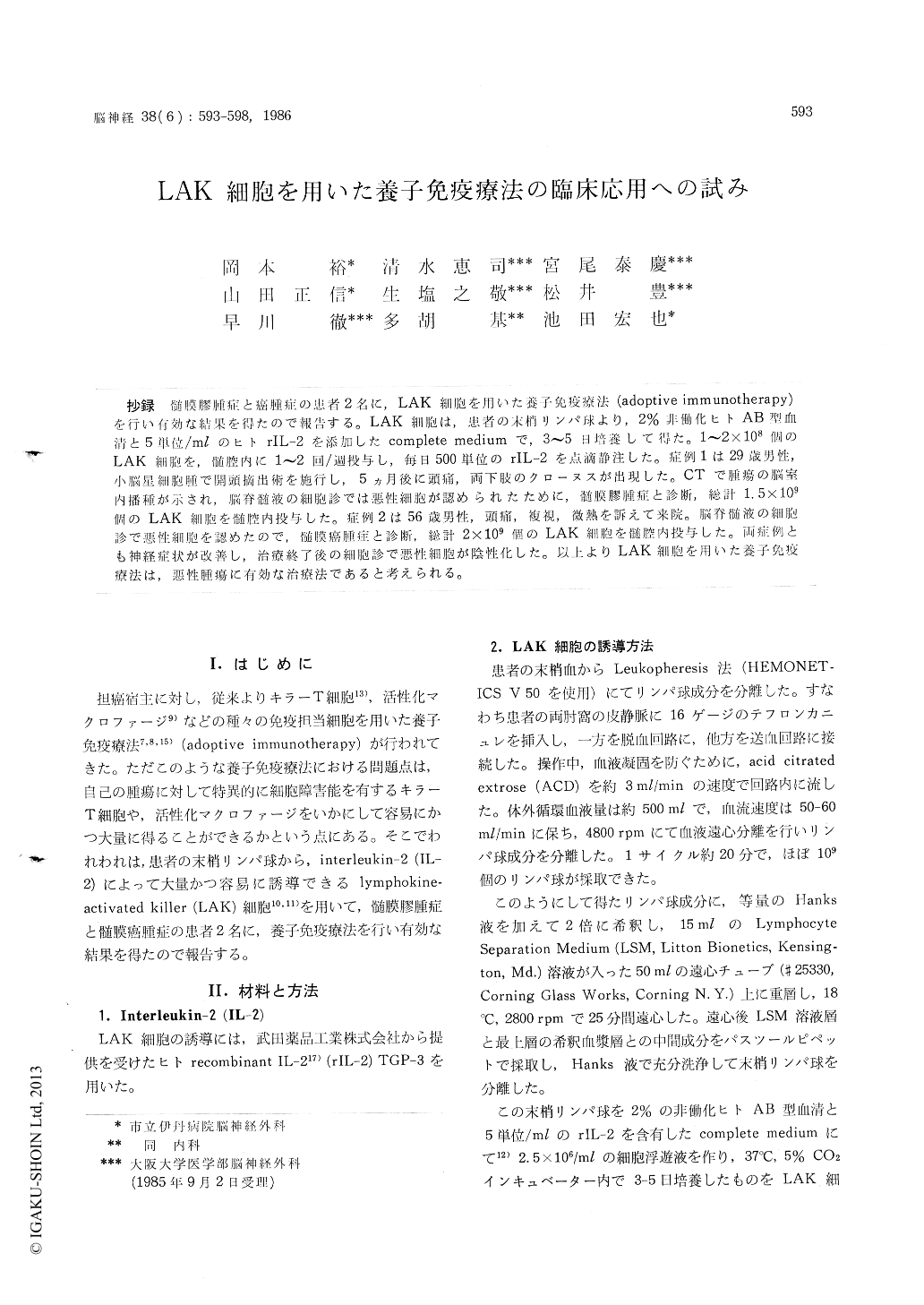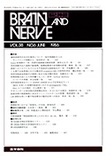Japanese
English
- 有料閲覧
- Abstract 文献概要
- 1ページ目 Look Inside
抄録 髄膜膠腫症と癌腫症の患者2名に,LAK細胞を用いた養子免疫療法(adoptive immunotherapy)を行い有効な結果を得たので報告する。LAK細胞は,患者の末梢リンパ球より,2%非働化ヒトAB型血清と5単位/mlのヒトrlL−2を添加したcomplete mediumで,3〜5日培養して得た。1〜2×108個のLAK細胞を,髄腔内に1〜2回/週投与し,毎日500単位のrlL−2を点滴静注した。症例1は29歳男性,小脳星細胞腫で開頭摘出術を施行し,5ヵ月後に頭痛,両下肢のクローヌスが出現した。CTで腫瘍の脳室内播種が示され,脳脊髄液の細胞診では悪性細胞が認められたために,髄膜膠腫症と診断,総計1.5×109個のLAK細胞を髄腔内投与した。症例2は56歳男性,頭痛,複視,微熱を訴えて来院。脳脊髄液の細胞診で悪性細胞を認めたので,髄膜癌腫症と診断,総計2×109個のLAK細胞を髄腔内投与した。両症例とも神経症状が改善し,治療終了後の細胞診で悪性細胞が陰性化した。以上よりLAK細胞を用いた養子免疫療法は,悪性腫瘍に有効な治療法であると考えられる。
In previous in vitro studies, the authors showed that recombinant interleukin-2 (rIL-2) stimulated peripheral blood lymphocytes (PBL) from patients with malignant brain tumors to generate cells that were lytic for fresh autologous tumor but not for lymphocytes or lymphoblasts. We then tried the adoptive transfer of such lymphokine-activated killer (LAK) cells induced from patients with me-ningeal gliomatosis (MG) and meningeal carcino-matosis (MC).
PBL fractions were separated into a plastic bag by leukophereses using HEMONETICS V 50. PBL were then harvested by LSM (Litton Bionetics, Kensington, Md.) gradient centrifugation according to the standard method. Human LAK cells were generated by placing 5×107 PBL in 10-cm diame-ter plastic dishes (Falcon) holding 20ml of com-plete medium (CM) containing 100 units of rIL-2 (TGP-3, provided by TAKEDA Chemical Indust-ries, Ltd.). The CM consisted of RPMI P640 with 0.1mM nonessential amino acids, 1μM sodium pyruvate, 5×10-5M 2-mercaptoethanol, 50μg/ml of gentamicin sulfate, 0.03% glutamine and 2% heat-inactivated human AB serum. The dishes were incubated horizontally at 37℃ in a 5% CO2 atmosphere for 72-96 hours. The LAK cells were then harvested, washed three times with Hanks' balanced salt solution (HBSS) and resuspended in HBSS for transfer to patients. 1-2×108 LAK cells were injected intrathecally through Ommaya's resevoir or a V-P shunt reservoir twice a week. Portions of LAK cells were tested for cytotoxicity in vitro. During the adoptive transfer of LAK cells, patients were given intravenous injections of 500 units of rIL-2 every day.
Case 1 A 29-year-old man with meningeal glio-matosis. He had undergone suboccipital craniec-tomy with subtotal removal of a cerebellar tumor on Nov. 6, 1984. It was diagnosed as an anaplastic astrorytoma by the pathological examinations. Five months after the first operation, he complain-ed of a severe headache and bilateral ankle clo-nus. A CT scan revealed a slight high density area (HDA) at the bilateral anterior horn of the lateral ventricle. This HDA was remarkably enhan-ced by contrast medium. Then numerous malig-nant cells were found by cytospin examination of the cerebrospinal fluid (CSF). Based on these find-ings, we diagnosed this patient as having me-ningeal gliomatosis and started adoptive transfer of LAK cells. After a total of 1.5×109 LAK cells were infused intrathecally, the headache and right ankle clonus disappeared. We could also no longer detect malignant cells in the cerebrospinal fluid.
Case 2 A 55-year-old man with meningeal car-cinomatosis. He sometimes complained of persis-tent headache, a slight fever and double vision since last January. He was admitted to our hospital on March 6, 1985. On admission, biopsy of swollen cervical lymph nodes revealed metastasis from latent tongue cancer (squamous cell carcinoma). A CT scan of the brain showed no abnormal findings but malignant cells were detected by the cytospin examination of the CSF. This patient was therefore diagnosed as having meningeal carcinomatosis which had metastasized from tongue cancer. He was transferred a total of 2×109 LAK cells intrathecally from April 16 to May 25. After this treatment, the headache and the slight fever disappered. The double vision was also improved. Cytospin of the CSF revealed no malignant cells.
The adoptive transfer of LAK cells to patients with intracisternally disseminated brain tumors was highly effective in reducing the clinical symp-toms and signs, and in elininating the malignant cells from the CSF. This adoptive immunotherapy was accompanied by repeated systemic injections of rIL-2. Thus, this therapy is an attractive ap-proach for the treatment of malignant tumors that have poor immunogenicity or are insensitive to several anti-cancer agents, and for patients with severe immunosuppressive conditions induced by repeated radiation therapy or chemotherapy.

Copyright © 1986, Igaku-Shoin Ltd. All rights reserved.


